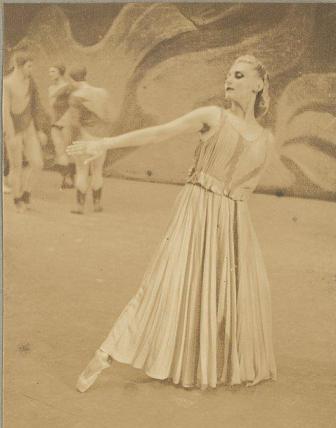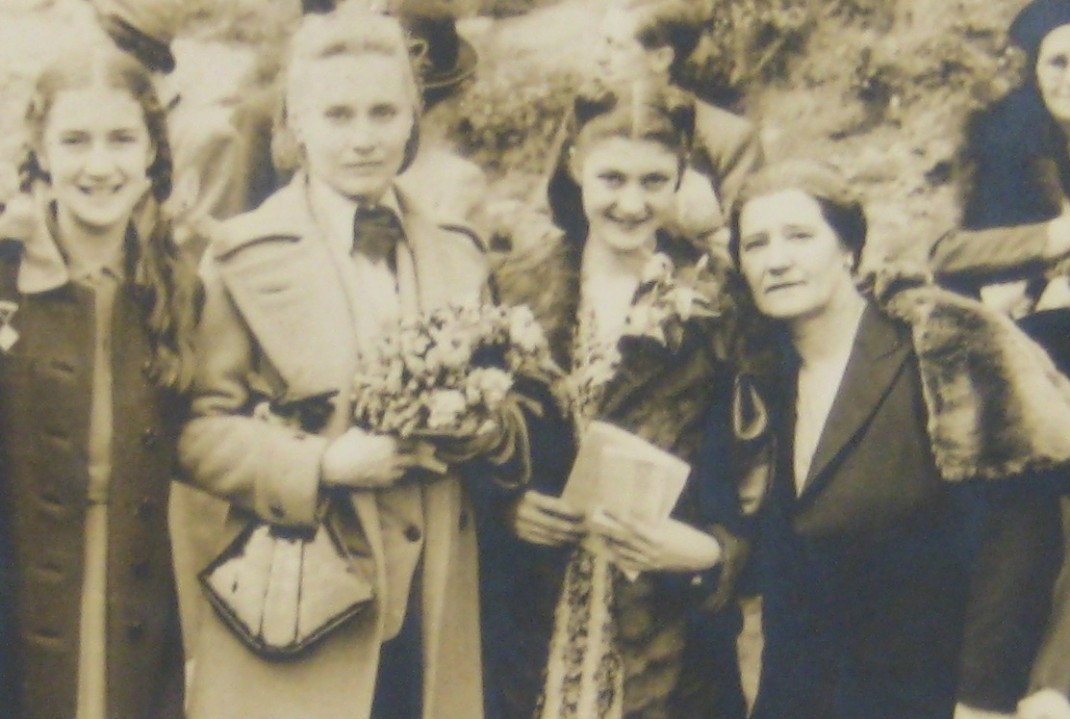Nina Verchinina, born in Moscow in 1910 and brought up in Shanghai and Paris, began her performing career in Paris in 1929 with the company of Ida Rubinstein. Throughout the 1930s she danced extensively with the Ballets Russes de Monte Carlo under various directors including René Blum, Léonide Massine and Colonel Vassily de Basil.
Verchinina came to Australia as a leading dancer on the 1939–1940 tour by Colonel de Basil’s Original Ballet Russe, arriving in Sydney on the Orcades on 18 December 1939. In Australia she was especially celebrated for her performances in Massine’s symphonic works, in particular as Action in Les Presages, a role she had created for Massine and had made her own following the work’s premiere in Monte Carlo in 1933. Writing in The Herald after Verchinina’s Melbourne debut in Les Presages, Basil Burdett wrote of her performance as Action:
‘Her interpretation of the role … is striking in its combination of energy and joyousness. To strong and beautifully marked rhythms she adds an emotion of delight in movement in a conception of the part which differs considerably from other versions we have seen.’

Verchinina was also the sister-in-law of de Basil—her younger sister, Olga Morosova (Olga Verchinina, born 1912), had married de Basil in 1938. As part of family business, Nina Verchinina involved herself in some of the publicity activities in which de Basil engaged while in Australia during the 1939–1940 tour. For example, photos show her with her sister, de Basil and others in Melbourne visiting Edouard Borovansky’s ballet school to watch his pupils.

But Verchinina’s visit to Australia was also marked by two significant encounters with individual Australians—one with composer Margaret Sutherland and one with young Australian dancer Valrene Tweedie.
On 9 May 1940 the Original Ballet Russe gave a charity matinee in aid of the Royal Melbourne and Children’s Hospitals. Dithyramb, one of the divertissements on the program, was a solo choreographed and danced by Verchinina. The music, also called Dithyramb, was by Margaret Sutherland and the collaboration attracted the attention once again of Melbourne critic Basil Burdett. He wrote in The Herald on 10 May:
‘Verchinina’s number, to music by Melbourne composer, Margaret Sutherland, alternately energetic and yearning in mood, showed her forceful style, based on the modernist expressionist mode, perfectly. Miss Sutherland’s music was finely adapted to the spirit and style of Verchinina’s dancing. One would like to see these two artists collaborate in a larger work.’
In her PhD thesis, ‘Reconstructing the creative life of Australian composer Margaret Sutherland: the evidence of primary source documents’, Cherie Watters-Cowan notes the development of the collaboration between Verchinina and Sutherland. Although it is a point she does not develop in any great depth, Watters-Cowan indicates that the music was written around May 1940 and originally as a solo for Verchinina. Sutherland later transposed the music for solo piano.
Although Sutherland and Verchinina never collaborated on a longer work as suggested by Burdett, Dithyramb was presented again at a midnight performance in Sydney on 19 September 1940 in a program entitled ‘Farewell Original Ballet Russe’. At this performance, Verchinina reportedly performed in a costume designed by Loudon Sainthill in tonings of black and red. The anonymous critic for The Sydney Morning Herald wrote:
‘One of the loudest and longest receptions was accorded to Nina Verchinina … Both score and choreography proved to be uncommonly vehement, and Verchinina brought to her interpretation all the force and fire which had made her work so popular during the tour’.
The next day the dancers left Australia on the S. S. Monterey bound for the United States. As she prepared to board the ship on 20 September, Verchinina sent Sutherland a telegram, ‘DITHYRAMB GREAT SUCCESS CRITICS AND PUBLIC WARM OVATION. VERCHININA.’
Also boarding the Monterey on 20 September was Valrene Tweedie, aged 15, about to begin a professional career as Irina Lavrova with de Basil’s Ballets Russes. Although she had been accepted by de Basil for his company, Tweedie was too young to be given a work visa for the United States without having a legal guardian. It was Verchinina who took on the role. In immigration documents completed when she arrived in Australia,Verchinina gave her name as Nina Verchinina-Chase and referred to identity papers issued in Sacramento, California, by the Secretary of State in May 1939, which gave her American status. Her husband at the time apparently was the American-born composer Newell Chase. This was enough to secure the visa. Verchinina attended Tweedie’s family farewell in Sydney in June 1940.

Verchinina’s career with de Basil continued briefly until 1941 and Tweedie recalls her fondly as a guardian who never interfered but who was always available if needed.
Tweedie encountered Vechinina again in Cuba in 1943 during a period when there was little work or money for dancers. At that stage Tweedie too had left the de Basil company and with her then-husband, Luis Trapaga, performed in a small group of just four dancers, which Verchinina had established and for which she choreographed and produced small works. Tweedie recalls that they performed at the National Theatre in Havana and then toured to Matanzas and San Fuegos.
There is still much to discover about Verchinina’s Australian connections. Her collaborative endeavours with designer Loudon Sainthill are yet to be adequately researched, for example. Her connections with Tweedie and Sutherland, discussed briefly in this article, were significant highlights in the careers of those two Australians. They also deserve closer examination.
© Michelle Potter, 5 August 2009
All images published with the permission of the National Library of Australia.
BIBLIOGRAPHY:
Newspapers: Basil Burdett, ‘Melbourne ballet lovers enthralled. ‘Les Presages: a first favourite’, The Herald, 2 April 1940, p. 10; Basil Burdett, ‘Successful ballet for hospital funds’, The Herald, 10 May 1940, p. 14; ‘New ballet tonight’, The Sydney Morning Herald, 19 September 1940, p. 19; ‘Midnight ballet. Enthusiastic audience’, The Sydney Morning Herald, 20 September 1940, p. 4.
Theses: Watters-Cowan, Cherie. ‘Reconstructing the creative life of Australian composer Margaret Sutherland: the evidence of primary source documents’, 2006. PhD Thesis, University of New South Wales, Sydney.
Other sources: Interview with Valrene Tweedie recorded by Michelle Potter, December 2004. Oral History Collection, National Library of Australia, TRC 5350; Telegram from Nina Verchinina to Margaret Sutherland, 20 September 1940. Papers of Margaret Sutherland, National Library of Australia, MS 2967, Box 1; ‘Personal statement and declaration: business visitor’, Nina Verchinina-Chase. National Archives of Australia, Item 6831038.
Yes, Nina was married to my uncle, Newell Chase (actually Jason Newell Chase). I found your article very interesting, as it clears up some of our family’s uncertainty concerning where Nona was during the war years. Also enjoyed seeing the photos. Thanks for making it available.
Thank you so much for your comment Barbara. It is a thrill to have confirmation of Verchinina’s marriage and to have the full name of her husband, your uncle. I am also very happy to have provided your family with more information about Verchinina’s career.
This sent me straight to Haskell’s ‘Balletomania’, in which he raves over Verchinina: ‘Who can forget her entrance in ‘Les Presages’? In it she reconciles so many seeming opposites: points with the plastic dance, enormous strength with fluid movement. What so many others have stressed in that part, she conceals.’
There’s much more that he writes, and she must have made a tremendous impression – certainly one feels that she was a very special dancer.
As part of my current research project I have just been skimming through and oral history intervew I did with Lynne Golding in 2001. I had forgotten entirely that Golding took classes with Nina Verchinina in Sydney at Leon Kellaway’s ballet school. According to Golding, Verchinina established conditioning classes which were specifically for doctors and lawyers as a kind of treament for stress. She certainly had some advanced ideas for the era.